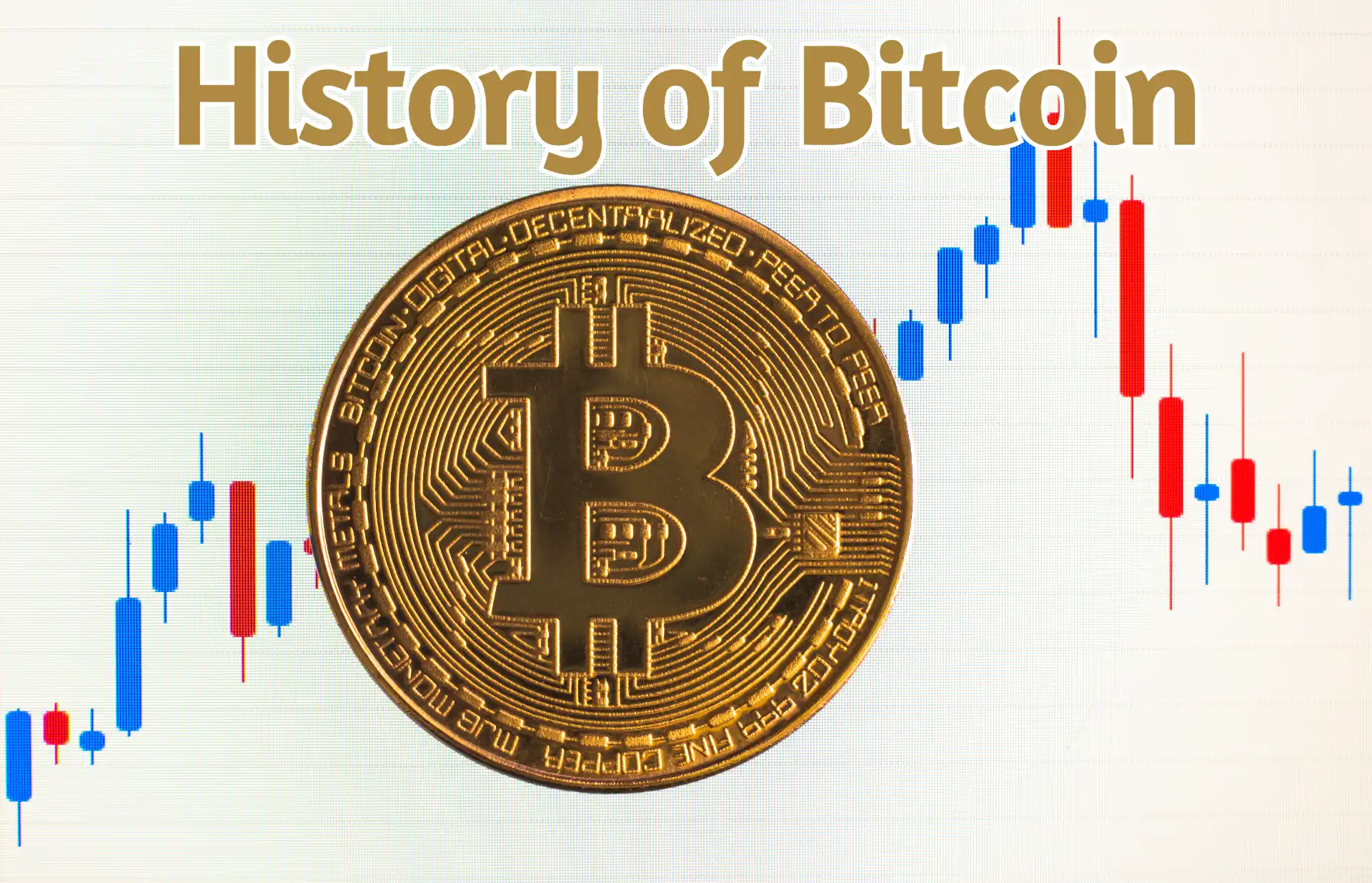In today’s article, I will talk about the history of Bitcoin, how bitcoin was invented, different significant events and activities related to bitcoin, why bitcoin is so popular, and the future of bitcoin. Bitcoin is the first cryptocurrency in the market, and while we are talking to bitcoin, we are talking somewhat about the history of cryptocurrency. If you are willing to know more details about the history of cryptocurrency, then you can read meta earn the previous article ” History Of Cryptocurrency From Starting to Now.”
Bitcoin is the first decentralized virtual currency created to make peer-to-peer transactions easier without involving intermediatory bodies like banks and any other financial institutions. In 2008 anonymous person willing to call himself Satoshi Nakamoto proposed the white paper of peer to peer decentralized payment system.
Hey, Guys, welcome to Meta Earn with a new informative article that will help you create a clear concept about Bitcoin. If you are new here and visit Meta Earn for the first time, please bookmark my sites for an easy revisit. Without making a further delay, let’s get into our main content.
Table of Contents
What is Bitcoin?
Bitcoin is the first decentralized virtual currency created to make peer-to-peer transactions easier without involving intermediatory bodies like banks and any other financial institutions. In 2008 anonymous person willing to call himself Satoshi Nakamoto proposed the white paper of peer to peer decentralized payment system.
Bitcoin is a form of digital currency created and stored electronically. It’s the first decentralized currency, meaning there isn’t anyone centralized bank that controls it, and no one controls it. Bitcoins aren’t printed, like dollars or euros — they’re made by people, and increasingly businesses, running computers all around the world, using software that solves mathematical problems.
Bitcoin mining is a procedure in which computers crunch numbers to release new bitcoins into the network and maintain its integrity. The Bitcoin system was initially devised so that no more than 21 million Bitcoins would ever be in circulation – which means there’s no way for a central bank to flood the market with new Bitcoins and devalue those already put into circulation. This is a pretty exciting development for human beings worldwide because now we have one of the first examples of a currency whose value is not determined by any government or institution.
What makes Bitcoin different from standard currencies are:
1) It’s decentralized – the network isn’t controlled by one central authority.
2) It’s open-source – anyone can look at its code, unlike standard currencies, which often have their codes kept secret.
3) It doesn’t rely on trusted third parties – while standard currencies depend on institutions like banks to process payments reliably and fairly, Bitcoin doesn’t have a trusted third party or institution controlling it. This means that transactions don’t have to clear through a central authority like a bank before they’re verified.
Bitcoin Quick Summary
Name: Bitcoin
Symbol: BTC
Date of Creation: 2009
Creator: Satoshi Nakamoto
First Mine Block: Genesis Block
Smallest unit: Satoshi ( 100000000 Satoshi = 1 BTC)
Timestamping Scheme: Proof-of-Work (PoW)
Algorithm: SHA-256
Monetary Control: Decentralized
Max Supply Limit: 21,000,000
Market capitalization: $ 730 Billion (6th March 2022)
Current Price: 38,414 (6th March 2022)
All-time High price: $68,000 ( Nov 2021)
All Bitcoin Fork: 105 (74 are active and 31 no longer relevant)
History of bitcoin
The history of bitcoin is a topic of debate. An anonymous person created Bitcoin in 2008 to make it easier for people to make transactions without involving any financial institutions and make it easier to carry out peer-to-peer transactions. The first bitcoin was mined on January 3, 2009, after the publication of its white paper in November 2008. After that, the development of this cryptocurrency has gone rapidly, and there have been numerous famous news stories about it. It is often considered one of the humans’ most significant inventions ever made.
It is not possible to cover the history of bitcoin in one paragraph. Before knowing the history of Bitcoin, it is better to understand the demerits of regulated currency (paper currency) first. Some major drawbacks of regulated currency (like US dollar, pound sterling, Norwegian krone, and similar) are listed below:
- Subject to Inflation
- Public Confidence
- High-level administrative work
- Regulation can be costly for regulatory bodies
- Rules and Regulations may vary from country to country
- The requirements of regulatory bodies can be controversial
- Central authorities (regulatory bodies) have complete control over our funds and more.
To overcome the demerits of currency managed and regulated by central authorities, the concept of a decentralized system is proposed, and then Bitcoin is the first decentralized currency. Now, let’s talk about the historical timeline of bitcoin in detail.
History Timeline of Bitcoin
The history of Bitcoin is ancient and complex. Although bitcoin was introduced in 2009, bitcoin-related technologies such as cryptography can be traced back to the early 1900 BC. While we are talking about the history of bitcoin, we must talk about the history of bitcoin before and after the starting of bitcoin.
Cryptography is not a new word to the world. Cryptography has existed in our community since ancient times. There are various opinions as to who started cryptography? And when cryptography invested? It is believed to have been first used by the Egyptians around 1900 BC encrypted by hieroglyphic characters instead of familiar and readable characters. That hieroglyph code is only read and understood by the Scribes who write and send the messages on behalf of their emperor.
Now let’s back to the main topic, the History Of Bitcoin. Cryptography was invented to make two parties’ deals and communication secure. The first recorded cryptography used is a Cipher device that military commanders use for secret communication. While talking about cryptography and its history, it is taken along, so please comment on us if you need to know more about cryptography and its history.
Pre-Bitcoin Era (Before 2008)
Generally, the time before 2009 resembles a pre-bitcoin era. Before the launch of Bitcoin, there were many attempts to create a decentralized currency, but not thriving. Various names contribute to the advancement of traditional cryptography and lead toward the present crypto implementation. Claude E. Shanno, One Leon Battista Alberti, Giovanni Battista Della Porta, etc., are some renowned names that contribute to cryptography. All credits go to these people for the present implementation of cryptography.
David Chaum( Cryptographer) is the first person that works on virtual coins. He is a Cryptographer and computer scientist from America. The first known proposal for a Blockchain protocol was David Chaum’s dissertation ( original research-based academic paper) in 1982. After his dissertation, America developed eCash based cryptography system. He is continuously working on a confidential transaction system, and after 12 years, he developed a cryptography-based secure payment system called DigiCash.
To date, cryptography is used to secure digital payment, but the term “Cryptocurrency” was introduced by Wei Dai in 1998. Wei Dai thinks about Cryptocurrency with decentralized features, and he contributes to the development of bitcoin and ether.
Although bitcoin was the first known Cryptocurrency before that, there were some attempts to create ledger encrypted cryptocurrencies that never success. B-Money and Bit Gold were the two examples formulated but not fully developed.
2008: Reason Behind the Starting of Bitcoin
Most of us already know about the USA 2008 financial crisis. In 2008 banks were providing risky loans for getting new customers, which will convert to bad debt. Due to this, many banks are collapsing, and the customers are losing their savings also. American government offered some money to the banks to overcome the bad debt.
All we know is that the money of government is ultimately the money of citizens that citizens paid to the government in the form of tax. So the trust in the government and the central bank is broken. Due to the 2008 financial crisis, the world’s economics was also unstable, not only in the USA.
And then, the decentralized currencies system was the main topic discussed worldwide. Many individuals and groups discuss and work on the decentralized system again. After that group of people says that “the money earn by the citizen’s hard work is solely the property of that citizen, government and the central bank has no right to control and regulate.”
People love the whitepaper posted by Satoshi Nakamoto during this financial crisis. Nakamoto posted Bitcoin-Peer to Peer Electronic Cash System paper on the cryptography discussion group. This paper creates a wave worldwide and changes people’s perception of virtual currency. Publishing the whitepaper for peer-to-peer electronic cash systems creates a significant milestone in the starting of Bitcoin. 2008 was the most significant year in the history of bitcoin and a turning point for the decentralized currency or even the whole world financial system.
2009: Starting of Bitcoin Network (World First Cryptocurrency)
The bitcoin opensource software is ready and launched for the public for the first time. Initially, people can start mining, and the whole process is recorded and verified on the blockchain begins; this is the first significant step/milestone in the journey of Bitcoin and the overall history of Cryptocurrency. The first bitcoin transition also occurred in 2009 when Satoshi sent ten bitcoin (BTC) to Hal Finney, a computer programmer, on 12 January. The first mining block was also recorded in 2009 and is known as Genesis Block before Satoshi sent 10 BTC to Hal Finney.
At the end of the year, the new Liberty Standard publishes the exchange rate for Bitcoin. In December, Satoshi Nakamoto released the second version of the software. At that time, people could buy 1309.03 BTC for $1 ( that is 0.000764 USD for 1 Bitcoin); this was the all-time low BTC price in history.
2010: First Commercial Bitcoin Transaction
On 15 august bitcoin system was hacked, which shows the major vulnerability in the system. One hundred eighty-four billion bitcoin unusual transaction is detected, and this transaction is noted by bitcoin developer Jeff Garzik and said publicly that” We have had a problem here.” After fixing this issue number of users mining and trading increases.
Bitcoin gets popularity as the first decentralized Cryptocurrency in the world. There is no real-world Bitcoin transaction; all the bitcoin holders use bitcoin as an online asset and are involved in trading and mining only. In late 2010 first bitcoin real-world transaction took place when a person in Florida bought a couple of pizzas for 10,000 Bitcoin. It would be more than $ 550 million at the current prices, enough to buy a pizza franchise hundreds of times. Although the buying pizza decision is not suitable for him, it gives some monetary value to Bitcoin and lifts the cryptocurrency potential in the history of Cryptocurrency.
2011: Rise of Bitcoin Competitors
After the successful operation of Bitcoin, other developer thinks over the alternative of bitcoin and the altcoins such as Litecoin, Swiftcoin, and Namecoin. Initially, Litecoin was considered the biggest Competitor of bitcoin because of its new algorithm that makes it a cheaper and faster transaction than Bitcoin. But the king is always remains king; the bitcoin price is Skyrock after the emergence of alternatives. In February, BTC crossed its 1 cent threshold, and after that, Bitcoin was worth $1 for the first time in the history of Cryptocurrency. All we know is that the price of Litecoin is far lower than the bitcoin on today’s date ( 1 LTC = $104 while writing)
After increasing the popularity of bitcoin, bitcoin was featured in TIME magazine for the first time. Same year bitcoin is frequently used in the dark web drug market, June Bitcoin worth crosses over $30 and soon crash back down to $10.
2012: First Halvening of Bitcoin
In 2011 bitcoin prices fluctuated, sometimes high and sometimes crashed back, but in 2012 BTC prices continuously and steadily increased and crossed their $100 threshold in April. And year 2012 is also a milestone year in cryptocurrency history because the first halving occurred in 2012. The process of cutting into the half after reaching specific criteria is called halving. On Bitcoin, according to white paper and algorithm, the halving process occurs when mining goes to 210,000 blocks and so on. The next halving happened in 2016, and the following halving is late 2020. Halving is necessary to maintain the amount of Bitcoin available because a finite number of bitcoin exist.
After halving, mining rewards were lesser than the previous, and it was less profitable to mine comparatively in the last years. Then in 2012, Paper for Peercoin was introduced; according to Paper for Peercoin, people can stake their coins and earn from staking.
2013: Cross $1000 Thresholds and Fork on Blockchain
On continuous ups and downs, Bitcoin price crosses $1000 thresholds for the first time in the history of Cryptocurrency and gets more public recognition. Bitcoin change specific rules regarding transactions, and the holders disagree, which lead to a fork on blockchain. I mean, blockchain was split into two parts and lasted for six-hour hours with two operating networks in parallel, which led to a significant drop in the price of Bitcoin. At the same time, various countries like Thailand and China banded Bitcoin and declared it an illegal activity. But At the same time, Canada launched the first bitcoin ATM in Vancouver.
2014: Mt. Gox Scam and Microsoft receive Bitcoin for games purchase
Mt. Gox, Japan, based world’s largest crypto exchange in 2014, was bankrupt and shutting down. Due to Mt. Gox’s down 850,000 bitcoin was lost by different investors, and they never got back their funds. Those lost coins are worth around $50 billion at today’s rate (while writing this article).
In 2014 blockchain 2.0 was launched, which is Ethereum blockchain, which refers to smart contracts. On the other side, due to the popularity of Bitcoin, Microsoft allows people to buy the game with bitcoin.
2015: Rise of the most prominent Bitcoin Competitor
Bitcoin’s biggest Competitor Ethereum is, started in 2015, though Vitalik Buterin started the development of Ethereum in 2013 by writing a whitepaper. Ethereum is the second-largest Cryptocurrency by market capitalization after Bitcoin. Though Ethereum addresses various cons and flaws of Bitcoin, it also has some limitations, which leads to the development of Ethereum killer cryptocurrencies like Solana and Cardano. Another big news about Bitcoin in the year 2015 is Bitstamp Hacked. In 2015 Bitstamp was hacked, and trading was interrupted for a few days. After the interruption of a few days, Bitstamp assures that all the customer’s funds are safe, and then they resume trading as usual.
2016: Bitcoin ATM Era
Cryptocurrencies are getting more popular day by day. There is a remarkable rise of Bitcoin ATMs; at the beginning of 2016, there were 500 Bitcoin ATMs and reached 900 plus at the end of 2016. Uber accepts bitcoin payments in Argentina. Bitcoin continuously grows due to its second halving and moving on positive trends. Considering Bitcoin price, 2016 is one of the significant years. Although there are many ups and downs, Bitcoin’s price is rising in the long run and reached $10,000 at the start of 2017.
2017: Fork on Bitcoin Network
All we know is that someone bought two pizzas for 10,000 BTC in 2010. Why do I repeat the same things that I have told you previously? Because this year, Bitcoin hists $10,000 a long way from 2010. In 2010 someone bought two pizzas for 10,000BTC, and now in 2017, the price of 1 BTC is $10,00 interesting to hear it. Now the BTC is the primary choice of new and early investors, which will support the BTC price growth after the previous halving in 2016. Many people are interested in searching for cashout funds in monetary currency to address the demand many financial institutions and governments legalize cryptocurrencies in their territory.
Halving is the main reason that leads to the fork on the bitcoin network. After the second halving in 2016, it was more difficult to mine bitcoin; many users were trusted due to more time, resources, and electricity costs while mining the same amount of BTC as previously. In August, two different users’ mindsets split the bitcoin network into two coins, Bitcoin (BTC) and Bitcoin Cash (BCH). According to its market capitalization, Bitcoin Cash is the 22nd most prominent Cryptocurrency today ( on the day of writing this article).
2018: Major Decline in BTC Price
According to the statistics, the whole crypto market dropped over $800 billion to $460 billion from 2018 to Mid January, including more than 1400 crypto assets. The price of the world’s largest Cryptocurrency, Bitcoin, declined by 67%, the all-time highest dropping price in the history of Cryptocurrency. Previously Bitcoin’s price hit $ 13,000 above in Dec 2017, and from the starting of 2018, its price continuously decreased and reached nearly $ 3600 at the end of 2018. We can say that 2018 is one of the darkest years for Bitcoin growth.
2019: BTC Price Increased by 120% at the Starting of Year
Bitcoin price is gradually increasing from $ 3400 to $ 7700 at the end of 2019. According to CoinDesk, Bitcoin price is increased by 120% since the start of the year. So far from the starting of Bitcoin, many people and communities have adopted cryptocurrencies, which leads to emerging new crypto tokens and coins day by day. Many ICOs and IDO are coming, and various popular companies like Facebook are also trying to enter the race of virtual currency and assets.
2020: Crypto Lending
All we know is that the 2008 economic crisis is the main reason behind the starting of Bitcoin; if there was no economical crisis in 2008, then no one knows when Satoshi released the white paper of Bitcoin, it may be delayed by some year or some decade. After the 2008 economic crisis, we faced one major crisis in 2020 due to the COVID-19 pandemic. Due to lack of liquidity, people need a loan for investing, business, or living. The financial institute allows them to get a loan (Fiat loan) against crypto security; this uplifts the Cryptocurrency leading to the next level.
2021: All-Time High | Country Legal Tender
The year 2021 is the biggest year for bitcoin, I am writing this article in 2022, and the highest price of Bitcoin is reached in 2021 April that is $64,800. While writing this article, the bitcoin price is $41346, which is 34% down with reference to its all-time high price. In February, April, and November of 2021, Bitcoin prices exceeded over $60,00o. Another significant step in the history of bitcoin is Some countries legalized Bitcoin in their territory and made Bitcoin their country’s legal tender.
2022: Year of Dilemma for Investor
Another darkest year for BTC holders is 2022. After crossing its all-time high, bitcoin went dramatically down, and many people lost their trust in it. Some people said that now Bitcoin price never goes back, and some said that this is the buying opportunity. Till the date of writing this article ( March 2022), no one has a clear idea about the future of bitcoin. Let’s see what happens to BTC; after a few months, we will update this article with more stats and facts about Bitcoin in 2022.
2023: Changing the Investor view points
In 2023, Bitcoin had a significant moment in its history. More mainstream investors paid attention to it, and people started seeing it differently. It used to be seen as something unusual and risky, but now it’s becoming a common part of investment portfolios, even for big financial institutions worldwide. A study in Australia showed that 15% of investors already owned Bitcoin, and about 30% were thinking about investing in it soon. This growing interest in Bitcoin reflects positive trends in the market and shows a major change in how people globally are investing. Even in a tough economic time, 2023 stood out as a good year for Bitcoin, especially compared to the previous year. Understanding why Bitcoin grew so much is important for investors thinking about adding it to their investment mix.
In 2023, the collapse of Silicon Valley Bank (SVB), the 18th largest US bank, due to a sell-off in US Treasuries, brought attention to the risks in the fractional reserve banking system. SVB’s substantial losses and subsequent bank run highlighted the advantages of decentralized currencies, boosting Bitcoin’s price to over $30,000. However, the year also saw setbacks, as the US SEC filed lawsuits against major exchanges Binance and Coinbase for offering unregistered securities. Despite this, BlackRock’s iShares unit filing for a spot Bitcoin ETF in June brought positivity, with Bitcoin’s value rising to nearly $26,000 and later hitting $35,000 after the proposed ETF’s ticker appeared on the DTCC’s website in October.
Shocking Facts about Bitcoin
1. Anonymous Founder
Satoshi Nakamoto published Bitcoin – A Peer to Peer Electronic Cash System in 2008, and after that, work on blockchain tehcnolgy started for creating bitcoin. Still, world unknown about who Satoshi Nakamoto is; Satoshi may be a person or group of people, the real identity of Satoshi Nakamoto is still mysterious to the world.
2. Limited Circulation
Unlike the Fait currency, the total maximum circulation of Bitcoin is limited and defined before the launch. Bitcoin has a max supply of 21 million coins that takes up to 2140 A.D. until the last bitcoin is mined.
3. Most Expensive Pizza
In mid of 2010, a U.S. Citizen from Florida state, Mr. Laszlo Hantecz, buys a couple of Pizza for 10,000 BTC. This is the first commercial transaction of BTC and the worth of two pizzas in today’s price (at the time of writing) is more than $550 Million, which is enough to buy a pizza franchise more than hundreds of times.
4. Excavate Land for Bitcoin
In 2013, Wales Citizen/ British Citizen James Howells through its hard drive with 7,00 bitcoin mining. After realizing the price and potential of Bitcoin after some year, he was searching the drive. He was trying to convince his local city council to allow him to excavate the dump yard for exploring his hard drive. He also offers a particular portion of his bitcoin profits to the authority if they enable him to look on the trash and excavate the dump yard.
5. Highly Volatile Assets
All we know and we have various real-life examples that Bitcoin makes some people millionaire/ billionaire, and at the same time, some people lose everything they have just because of a high drop in the Bitcoin price. So Bitcoin is considered a highly volatile asset.
6. No Backing System
Unline real money; Bitcoin has no fundamental backing. We know that every country’s currency is backed by the government and center bank, responsible for circulation and monitoring it. No such support is available on Bitcoin; that’s why it is called decentralized currency.
7. 20% of Bitcoin last forever
According to data, 20% of the total BTC supply (equal to 3.76 Million BTC) has been stuck or lost and cannot access. If you wonder how that’s possible, there may be various reasons. 1.1 Million BTC is held by creator Satoshi Nakamoto and never used, and people believe that Mr. Satoshi will never use these coins in the future. Sadly some people live in this world without sharing their wallets access. Some people lost their security phrase or keys.
8. Legal Tender in Some Country
Due to the increasing popularity of Cryptocurrency and potential future countries, think about making a crypto legal tender of their country. In this race, El Salvador is the first country that makes BTC legal Tender for their country, and Cuba is the second country that makes Bitcoin a Legal Tender for their country.
9. Wait until 2140 to mine the last Bitcoin.
According to the bitcoin blockchain script, only 21 million bitcoin is produced lifelong. This makes the total supply limited already mentioned on the script. 18.8 million BTC have already been mined, and some have already been lost. And we know that the mining reward is half every four years, and the process is called the halving. According to the calculation and halving process, Miners can only mine the lass bitcoin after 120 years. So the last BTC mining time is 2140. Interestingly, we need to wait more than 120 years to see the last Bitcoin.
10. First Bitcoin Mortgage
Former child actors of The Mighty Ducks Fame and Entrepreneur Brock Pierce take out fully crypto-based mortgage service. He Put up more than 3 million Bitcoin to buy a chapel in Amsterdam. And in the other side, the U.S. Mortage lender ( United Wholesale Mortgage) started accepting Bitcoin payments.
11. There have been 715 Million Bitcoin Transactions.
According to Blockchain.com, the total number of Bitcoin transactions since its launch in 2009 is 715 million, and that number has increased more steeply in recent years. At the time of this writing, an average of 225,321 transactions took place each day.
12. Bitcoin ATMs
We know that Bitcoin is not real money, but still, there are ATMs for Bitcoin transactions. Bitcoin ATM accepts bitcoin and converts it to fiat cash, and also accepts Fiat currency and converts it to digital assets like Bitcoin. There are around 6000 Bitcoin ATMs all around the world.
13. High Power Consumption and Processing Power
Bitcoin mining needs high power consumption, which costs more electricity use, and the price of mining is automatically increased. And miner also needs high processing devices to mine Bitcoin, like dedicated mining processors or compatible gaming processors.
14. Bitcoin Network Processing is Faster than Supercomputers
The world’s fastest Supercomputer has 122.3 petaflops processing power, and Bitcoin network processing power is about 80,704,290 petaflops which are 659888 times faster than supercomputers. The difference between the Bitcoin network and Supercomputer is that Bitcoin Network is used to add blocks to the blockchain only, and Supercomputer can multi-task.
15. Satoshi Vision
The mysterious creator of bitcoin, Satoshi Nakamoto, is a visionary person. He defined the value of Satoshi at the time of the creation of Bitcoin; 100 million Satoshi makes 1 BTC. Why did he define the smallest unit of bitcoin as 100 million? Does anyone think about this?. Why does 100 cent makes 1 dollar but for 1 Bitcoin, there is 100 million Satoshi? The answer to all the questions is the Vision of Satoshi Nakamoto. He has some idea that the price of Bitcoin will skyrocket and define the most negligible unit possible. He already knows that people having 1 BTC are the wealthiest person, and an ordinary person only has certain Satoshi in the near future.
16. Bitcoin and bitcoin are two different things.
Most of you are unknown about the difference between Bitcoin and bitcoin. Bitcoin with ‘B’ and ‘b’ both have different meanings. The ‘Bitcoin‘ word refers to the whole payment system or network. And ‘bitcoin‘ word is usually used for the currency.
17. First Cryptocurrency to go to Space
In 2016 Genesis Mining, a cloud computing company tied a Bitcoin paper wallet to the ballon and sent it to Space. The flew balloon was tracked by GoPro and made a successful transaction from an altitude of 21 miles.
18. FBI holds a significant amount of Bitcoin
In 2013, the Federal Bureau of Investigation (FBI) was confiscated over 144,000 BTC from the Silk Road founder Ross Ulbricht. Ross Ulbricht runs an illegal online marketplace that sold illegal drugs, untaxed cigarettes, and forged documents in the name of the Silk Road website.
Some Frequently Asked Question About Bitcoin
Who Created the Bitcoin?
Nobody knows the real identity of Satoshi Nakamoto, and he might be an individual or a group of people. The only thing that is known is that he developed the idea of Bitcoin and implemented it in 2009 as open-source software. Bitcoin was created to respond to fatal problems in the traditional financial systems such as corruption, austerity, failure, and high transaction fees.
How Bitcoin Works?
Ans: Bitcoin is a network of people who send and receive Bitcoin. Transactions are made by broadcasting digitally signed messages to the entire peer-to-peer network. There’s no central authority, so no one person or organization has control over the system.
Bitcoin is a decentralized currency, which means it doesn’t rely on banks or other financial institutions to make transactions possible. For someone to transfer Bitcoin, they have to broadcast digitally signed statements about the transaction to everyone in the network. This process can take 10 minutes for just one confirmation for small transactions, but it could take up to an hour for more significant transactions.
Users are encouraged to use their computer power (or “mine”) to verify transactions to avoid any centralized control system. These transactions are verified by other users of Bitcoin and recorded in what is called “blockchains.”
There are many ways to get Bitcoins: You can earn them from mining, purchase them from exchanges or “buy” them directly from anyone willing to sell them on the internet through marketplaces similar to eBay…
Who Controls Bitcoin?
Ans: Bitcoin is not controlled by any central authority; depending on transactions, it can take anywhere from 10 minutes to over an hour for a transaction to be verified. There are some security issues with bitcoin as anyone can create a new bitcoin address and start sending bitcoins without any proof of identity.
Is Bitcoin Legal?
Ans: Bitcoin is not illegal, and there are several ways to use Bitcoins legally through investments or as an online currency for online transactions.
Some people believe that Bitcoin is illegal because governments or banks do not regulate it. However, it doesn’t mean that Bitcoin is illegal in any country, and it just means that Bitcoin isn’t the same as fiat currencies like US dollars and euros. Countries like Japan, Germany, and Russia recognize bitcoin as legal tender, while other countries are still debating on its legality.
How is Bitcoin Invented?
Ans: Bitcoin is invented to address people’s dissatisfaction towards central authorities who control the monetary policies. After the financial crisis of 2008, people widely discussed the concept of decentralized virtual currency. After some time, the anonymous person Satoshi Nakamoto released the white paper about the concept of peer-to-peer digital money. Though Satoshi started Bitcoin in 2009, most of the world takes decades to adopt decentralized-based currencies.
When did Bitcoin Start?
Ans: Bitcoin was first launched in 2009 by the mysterious creator Satoshi Nakamoto. In the initial version of Bitcoin, Satoshi defined 3000 lines of code only, but now after many improvements, the latest Bitcoin network version contains more the 100K lines of code.
How Bitcoin Works?
Ans: Bitcoin Network works on the blockchain protocol. Blockchain technology maintains the ledger that verifies every transaction of bitcoin. Every bitcoin is a computer file or data that cannot have a physical shape and size. Still, we can store and manage it by digital wallet through electronic devices like computers, smartphones,s or cold wallets (USB-like devices for crypto storage). The ledger maintained by blockchain technology is not stored in a single place, it is distributed all over the networks, and no one can easily manipulate the transaction. In simple words, it is decentralized, and no central body can manipulate the transaction.
What is the Future of Bitcoin?
Ans: As we all know, bitcoin is the first decentralized currency that is possible to create and the largest Cryptocurrency according to its current price and current market capitalization. Though we saw a significant fall in bitcoin price from its all-time high in Nov 2021, it is still struggling to defect its all-time high records. According to different financial research, Bitcoin price is growing and soon crosses its previous record. They defined the present state of Bitcoin price is as a buying opportunity. As per many studies price of Bitcoin may exceed $1 million by 2030 and $1 million to $10 million by the year 2040. We know that the future is uncertain but knowing the people who believe and trust Bitcoin may increase shortly.
What is the history of bitcoin and other cryptocurrencies?
Ans: For learning the history of Bitcoin in detail, you can consider this article and read from top to bottom without skipping any content. I am sure that you will get accurate information of genuine reason and scenario. And suppose you are willing to read the detailed history of Cryptocurrency from ancient times to the modern world. In that case, you can read the “History of Cryptocurrency from starting to now” article for more knowledge.
How to check the history of a bitcoin address?
Ans: All the bitcoin transactions are stored on Blockchain technology which can easily be seen on a blockchain explorer. Blockchain.com also provides API by using API anyone embeds bitcoin transaction checker on their website for their customers. Bitcoin explorer needs your bitcoin address for checking. After placing your address, explorer shows the total bitcoin on your address, total receive, and send according to date and sender address details. Bitcoin allows us to make transactions anonymous, but anyone with our address can see our activity easily.
Are bitcoin miners illegal?
Ans: There is no exact answer to this question. Bitcoin is a decentralized currency, and no central body controls its monetary value. Some country makes it legal in their territory, and some are not. For those countries where the use of bitcoin is legal, miners are also legal, and for those countries where the use of bitcoin is illegal, their miners are illegal.
Are bitcoin profits taxable?
Ans: Yes, Bitcoin is taxable. Different countries make different policies related to the taxation of crypto assets and deduct tax on profits. Some countries deduct tax even there is no profit. But one big challenge about deducting tax is a decentralized exchange or trading platforms. A centralized exchange platform is created under the company rules and regulations of their territory, making it easy to deduct tax. But in decentralized trading and exchange, it is hard to track the company details and user details; this makes it almost impossible to deduct the tax on a centralized exchange or trading.
Can bitcoin be hacked?
Ans: All we know is that there is nothing that is invulnerable. Everything has a loophole or bug, and the hacker takes benefit of such loophole and hacked. It is difficult to hack the whole blockchain technology but not impossible. Blockchain is a highly secured protocol that protects our crypto assets. Because of the security of blockchain technology, hackers try to hack users from different crypto wallets and exchanges.
Are bitcoin transactions anonymous?
Ans: Yes, bitcoin transition is anonymous, but if anyone knows your bitcoin wallet address, then they can track your account activity just by checking your address in the blockchain explorer.
How bitcoin ATM works?
Ans: Bitcoin ATM works like a regular ATM, and Bitcoin ATM allows us to use cash to buy bitcoin and send it to our desired address/wallet. And Bitcoin ATM also allows us to sell our bitcoin and receive other fiat currency or precious metals like gold and silver.
Where is Bitcoin legal?
Ans: Many territories make bitcoin and bitcoin transactions legal. Major countries like the USA, UK, Canada, etc., make bitcoin legal. Some country Like El Salvador makes bitcoin a country’s official legal currency.
Where is bitcoin illegal?
Ans: Right now, very few countries make Bitcoin and Bitcoin transactions illegal on their territory. This number is gradually decreasing, and in the future, every country may make Cryptocurrency legal on their territory. As per 2022 January stats, the following country banned bitcoin and Cryptocurrency on their territory.
- Algeria
- Bangladesh
- Bolivia
- China
- Colombia
- Egypt
- Indonesia
- Morocco
- Nepal
- Nigeria
- Qatar
- Turkey
- Vietnam
What is Bitcoin halving?
Ans: After mining 210,000 blocks, the miner’s reward is decreased to half, and the process is called halving. Halving reduces the supply and increases the price of bitcoin. Halving makes it challenging to get rewards for miners compared to previous, which finally increases the demand for bitcoin.
When is bitcoin’s next halving?
Ans: Bitcoin mining halving occurs every four years, the last halving occurred in 2020, and the next is expected in 2024.
Conclusion
Bitcoin is the world’s first decentralized digital currency and the first to use a public ledger. It was invented by Satoshi Nakamoto, who published the invention on 31 October 2008, so that people could buy goods without any third-party interference. A single entity does not control it, and it is not a type of currency backed by a government or central bank. It has its value, which can go up and down.
In conclusion, My main motive for writing this article is to provide you the information related to the history and growth of Bitcoin in one place. Here in this article, I am covering the history of Bitcoin with some interesting facts. Here I cover all the History Of Bitcoin From Starting to Now, along with some interesting facts and incidents related to Cryptocurrency.
If you love this history of Bitcoin, and this article may add value to your knowledge database, please comment on us. If you love this article, you may like another similar article on “History of Cryptocurrency.” We are always happy to hear from you, and your comment is our motivation. Thanks for reading my hard work, and so glad to see you again in my next article. Bye-Bye.








